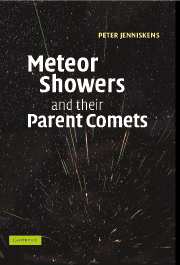Book contents
- Frontmatter
- Dedication
- Contents
- Preface
- Acknowledgements
- Part I Introduction
- Part II Parent bodies
- Part III Young streams from water vapor drag
- Part IV Young streams from comet fragmentation
- 20 Quadrantids
- 21 Broken comets
- 22 Geminids
- 23 The sunskirting Arietids and δ-Aquariids
- 24 α-Capricornids and κ-Cygnids
- 25 The Taurid complex
- Part V Old streams and sporadic meteoroids
- Part VI Impact and relevance of meteor showers
- Appendix
- Tables
- Index
- Units and constants
21 - Broken comets
from Part IV - Young streams from comet fragmentation
Published online by Cambridge University Press: 05 July 2015
- Frontmatter
- Dedication
- Contents
- Preface
- Acknowledgements
- Part I Introduction
- Part II Parent bodies
- Part III Young streams from water vapor drag
- Part IV Young streams from comet fragmentation
- 20 Quadrantids
- 21 Broken comets
- 22 Geminids
- 23 The sunskirting Arietids and δ-Aquariids
- 24 α-Capricornids and κ-Cygnids
- 25 The Taurid complex
- Part V Old streams and sporadic meteoroids
- Part VI Impact and relevance of meteor showers
- Appendix
- Tables
- Index
- Units and constants
Summary
Whipple's ejection model finally did away with old fashioned ideas about meteor showers originating from the breakup of comets. Or so it seemed. For many years, asteroid-looking minor planets that might be nonactive comet fragments were linked to meteoroid streams, but always leaving much discrepancy between the orbit of meteoroids and the minor planet. The one exception, when Fred Whipple noticed that 1983 TB was moving among the Geminids, was in doubt because the minor planet looked more like an asteroid than an extinct comet nucleus. Still, with only eight objects discovered so far having q = 0.09–0.17 AU and i = 19–28°, I estimate the probability of this good a match at perhaps one in 2 million, depending on the actual distribution of minor bodies.
That has now changed. While writing this book, I discovered that minor planet 2003 EH1 was among the Quadrantids (Chapter 20). With only four high inclination prograde (i = 60°–90°) moving objects with a = 2.5–3.5 AU discovered to date, the probability of finding an object with this good a match to the Quadrantid stream is also only about 1 : 2 000 000. The narrow range of orbital elements implied a young ∼500 yr age for this massive stream, tracing its history back to the sighting of comet C/1490 Y1, at which time the stream may have been created during a breakup.
A year later, I found a second minor planet 2003 WY25 in the orbit of the Phoenicid meteoroid stream, which had an outburst in 1956. Even though there are many more low-inclination objects discovered to date with an aphelion near Jupiter, this object matched the stream with a probability of better than 1 in about 4000. 2003 WY25 appears to be a ∼400 m fragment of the original ∼2.2 km sized nucleus of D/Banpain (see later in this chapter).
During the course of writing this book, I also identified 2004 TG10 (Taurids) and 2002 EX12 (α-Capricornids), and others as probably associated with known streams (Table 7). These parent comets and their meteoroid streams are the topic of the next chapters.
- Type
- Chapter
- Information
- Meteor Showers and their Parent Comets , pp. 377 - 396Publisher: Cambridge University PressPrint publication year: 2006



